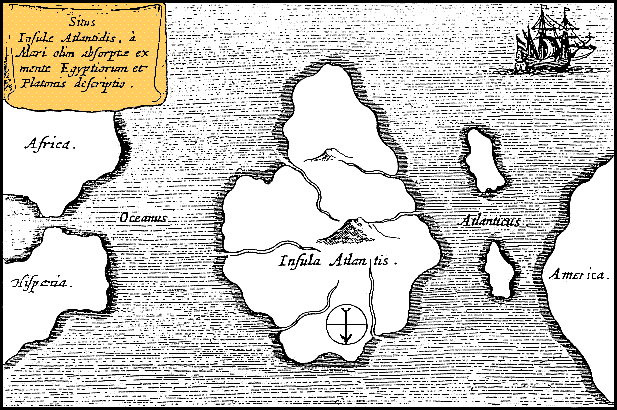NascoBLOG 3

Athanasius Kircher's Map of Atlantis (c.1669). Note that north is at bottom.
Hello again. Welcome to NascoBLOG3
How did you get on with the NascoBLOG2 question? I would like very much to hear the route you chose and what you looked for in the way of evidence of Phoenician activity. Don't forget, Google Earth is a wonderful tool and can make you feel you are actually on expedition. Maybe, you too, will make some new and exciting discoveries. If you wish I will publish them for you on NascoBLOG.
(Please don't forget - all pictures downloaded via G.E. must have a full Attribution in place)
In NascoBLOG2 we touched upon a theme which appears to link Greek Mythology with the discoveries described in "Portraits of the Gods" - either the book or the brief resume' on my Book's Promo video.
Historical background
First and foremost let me give you a little historical background. Phoenicia was a commercially orientated Empire of Sea Peoples who had created new markets world-wide for their goods and raw materials like gold, silver and iron ore, but especially tin which was used in the manufacture of bronze artifacts.
It is recorded historically that the Phoenicians feverishly guarded commercial knowledge from competitors, like the Greeks, and later the Romans after they had conquered the Greek's major trading port of Carthage on the Mediterranean coast.
However, this begs the question; if that's the case, how does one account for finding sculptures (intaglios) of a multi-cultural society memorialised in perfect condition and harmony right across the Phoenician 'New World Kingdom' of Peru, South America, as described in "Portraits of the Gods"?
Please bear in mind that once a transliteration of the many legends and inscriptions becomes available the whole scenario could change overnight.
The Phoenicians in South America
The main occupation and activity period of the Phoenicians and their compatriots in South America seems to have taken place peacefully in the 800 years between 1200 B.C. and a little after 400 B.C; these dates coincide extremely well with Greek mythology, e.g. Plato 1200 B.C. and Homer 400 B.C. running parallel with the chronology of the Phoenicians 'New World Kingdom', as tabled in "Portraits of the Gods".
The theories in NascoBLOG2 (Mattievitch/Mertz/Pellech) hypothesised that the 'myths' related by Homer suggest Odyssey's voyage was a carefully disguised visit to the Andean region of Peru wherein lay the true 'Kingdom of the Dead' and the approach route, the "Great Highway", was Homer's 'Highway of the Dead'.
It is clear from the statements made by Plato and Homer that they were referring to something other than a 'small' island in the middle of an Ocean. They were adamant that the 'Island' was larger than Libya and Africa put together. They were, of course, referring to a 'Continental' Island - fitting exactly the description of South America.
Add to this the discoveries described in "Portraits of the Gods" - a 'New World Kingdom' crammed full of long dead ancestors and a statue lined "Great Highway" leading from the South Coast of Peru up into the high Altiplano, and there we have it, the perfect location for Homer's 'Kingdom of the Dead' and his 'Highway of the Dead'... on a 'Continental' Island called 'Atlantis'.
In NascoBLOG4 we will discuss the historical background to 'Atlantis 'and why I believe my research programme, quite unwittingly, uncovered one of the World's last great mysteries.
So, my question for NascoBLOG4: Based upon the discoveries described in "Portraits of the Gods" and the mythological tales by Plato and Homer, Do you believe the Phoenicians 'New World Kingdom' could be the long lost island of 'Atlantis'?
To order your copy of "Portraits of the Gods" simply 'Click' the here.
William James Veall